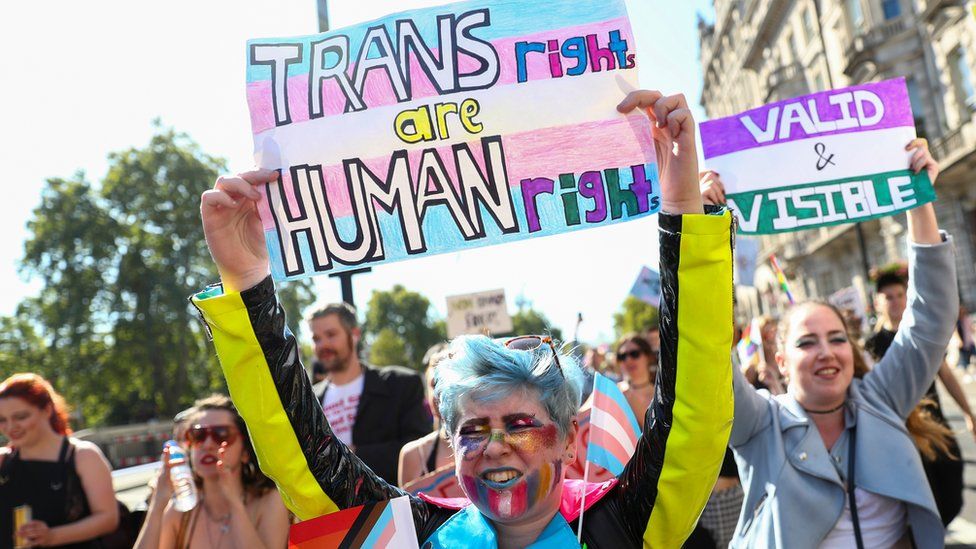By Éveline and Koerian (ISA in Belgium)
The right of transgender women to participate in sporting activities is being questioned. Last year, the International Swimming Federation (FINA) and World Rugby, among others, banned transgender women from participating in their competitions. Several U.S. states have banned the participation of transgender women in college and school sports, which for many young people are means of securing scholarships.
The far-right claims they want to protect women’s sports by excluding transgender people. In reality, various sports federations and far-right politicians, are trying to divert attention from the huge deficits and disinvestment in women’s sport. At the same time, they hope to score political points on the back of one of society’s most vulnerable groups.
Ever since the International Olympic Committee (IOC) decided in 2021 that sports federations should create their own rules around trans people, the ball got rolling. Right-wing politicians, journalists and (social) media figures put enormous pressure on sports federations. Several federations moved to completely ban participation or use a criteria of extremely strict testosterone levels. However, these policies did not come about in a vacuum; they had been in the IOC’s ground rules for years. It was them who installed a testosterone threshold in 2015, opening the door for national sports federations to do the same.
These repressive and narrow-minded rules to prevent trans people from participating in competitions are based on bad science. They look for reasons to disqualify trans people by relying on a long history of gender verification that puts trans and intersex people under the microscope. The most debated rules are those of World Athletics (WA), the international athletics federation. WA lowered the threshold for testosterone in all disciplines to 2.5 nmol/l. The same rule has already applied to shorter running events since 2019. This means that even non-trans athletes like Mbomba, Semenya, Niyonsaba — designated female at birth but with higher testosterone production — must suppress their testosterone levels with medication for two years before they are allowed to compete again. That is the de facto end of their careers.
What the science says
There is no evidence that transgender women have an advantage over cisgender women. The Canadian Anti-Doping Agency (CCES), conducted a meta-analysis of all English-language scientific literature published between 2011 and 2021 concerning transgender women in sport. The conclusion is clear: “There is currently no substantial research that indicates biological advantages precluding the equitable participation of transgender women in elite women’s sport.” There is no evidence that transgender women who choose to suppress testosterone (through, for example, gender-affirming hormone therapy and/or surgical removal of the gonads) retain disproportionate advantages over cis women.
There is no consensus on the lasting effects of male puberty or gender-affirming hormone therapy on athletic performance. There is not even a consensus on just what constitutes an unfair advantage within an elite sports world that celebrates genetic outliers. What is certain is that testosterone levels and red blood cell counts (responsible for transporting oxygen to muscles) of trans women fall within the usual female values. Moreover, blocking testosterone production brings about a whole host of other effects: muscle breakdown, weight gain, lethargy, depression and red blood cell loss. Not nothing, in other words. What is certain is that no one transitions in order to perform better in another category in sports.
Lia Thomas is perhaps the best-known example of a transgender athlete who has come under fire. Prior to her transition, Lia Thomas was one of the top U.S. swimmers in the men’s category. The year after she began gender affirming hormone therapy, she was 554th in the men’s category. In the ‘21-’22 swimming season (when she was forced to drop out) she was the nation’s 46th female swimmer. The right cried out indignantly, pointing to a top-ten finish in a swimming competition after her transition, but in fact Thomas’s performance deteriorated considerably. The idea that men would go through years of transition in order to win in women’s categories is ridiculous.
Instead of scientific evidence, the right and various sports federations base their decisions on a sexist image of women. A woman who is muscular, tall or has an angular jaw or deep voice is immediately suspicious. Throughout her tennis career, Serena Williams was told she was too masculine because she was muscular. MMA fighter Cris Cyborg, among others, was described as masculine by commentator Joe Rogan. Basketball player Brittney Griner’s gender was called into question when she defended the inclusion of transgender people. Transphobes opportunistically exploit sexist stereotypes already present in our society.
USA: witch hunt on transgender youth in sport (and beyond)
In 2020, the US Republican Party opened the hunt for transgender people in several states where it has a majority. Under the pretext of “protecting fundamental justice”, 21 states now ban transgender women from participating in women’s sports teams at schools and universities that receive public funding, around 30% of LGBTQIA+ people now live in a state where such a ban has been issued.
The purpose and effect of these laws is to prevent transgender women from participating in sporting activities, an essential means of building self-confidence, forming friendships and managing stress. These laws further isolate transgender women and girls and exacerbate discrimination.
According to conservative politicians, trans girls would have an unfair advantage in the competition for scholarships. American higher education costs a fortune. Sports scholarships are an important way for working-class youth to access higher education without taking on lifelong debt. Like the underfunding of women’s sports, the lack of access to education creates an extremely competitive sports environment. This perverse system is now being abused by conservatives to exclude trans women from sports. However, research shows that schools and universities that work toward trans inclusion also score better on inclusion of women in sports. If politicians really cared about women’s opportunities in education, they would abolish tuition fees and cancel existing student debt.
Although there is little evidence of widespread working-class support for these policies (only 8% claim to have followed news reports on the subject), the Conservatives’ ongoing campaign to scapegoat transgender people is having a measurable effect on public opinion.
Access to top-level sport
Transphobes distract attention from the many problems facing top-level sport, and women’s sport in particular. If there is a difference in level between men’s and women’s sport, it is more often due to the huge difference in funding and coaching than to the intrinsic abilities of the athletes.
Societal sexism means unequal access to top-level sport. Women are less encouraged than men to take part in sport. Only a minority of top-level women athletes have full-time status. Most top-level sport depends on private investors and mafia-style sports associations. The under-funding of women’s competitions makes the competition for contracts, sponsors, scholarships, etc. even tougher than in the men’s categories.
The logic of competition in top-level sport, combined with the lack of opportunities in women’s sport, is a godsend for transphobes. They apply their favorite divide-and-rule tactics by raising fears of fewer opportunities for competition, awards, sponsorship and media coverage.
In reality, high-level trans and female athletes face similar obstacles: a lack of research into performance and training methods, discrimination on and off the pitch, a lack of role models and professional support to name but a few. If sports federations and governments really cared about equitable women’s sport, they would invest heavily in training, research and competitive opportunities. But today even fair pay and decent minimum wages are too much to ask.
Access to amateur sport
The right to sport and physical exercise for all is even more important than access to elite sport. Transgender people face many obstacles. They suffer more physical and sexual violence than cismen and ciswomen, which makes sport in public spaces much less accessible. When transgender people go to a public gym or sports centre, they are almost always confronted with binary facilities: men’s and women’s changing rooms, men’s and women’s toilets… They are often confronted with gendered sports programmes: zumba classes for women, strength training for men. Commercial sports clubs exploit gender stereotypes to sell memberships.
The same goes for sports classes at school. Often trans people are forced to change in a locker room that does not fit their gender, are confronted with teachers and fellow students who do not use proper pronouns or are even excluded. In amateur competitions, transgender people also face discrimination, misunderstanding and hatred. This makes recreational sport a very unsafe place for trans people.
Safe spaces
Against this backdrop, “LGBTQIA+ friendly” sports clubs and “safe spaces” are gaining ground. It’s only logical that direct solutions are sought to ensure safety and enable the practice of sport. However valuable these initiatives may be, they remain isolated in a society rife with transphobia, and often come up against the same negative reactions and difficulties encountered by individual transgender athletes. It’s not an alternative to inclusion either. Trans individuals should be able to enter any sports club. Safe spaces run the risk of feeding the idea that trans people should just create their own separate place, category or club.
True inclusion requires investment. The fight against transphobia must go hand in hand with a demand for better use of public space for all: more public transport, more leisure spaces and public sports facilities staffed by sufficient and properly trained personnel. That way, trans people are not dependent on the ‘goodwill’ of commercial sports chains or the use of a few safe spaces. We need resources to train sports coaches in gender inclusivity, more resources for schools and clubs to have time for a personalized approach to athletes. More generally, schools need sufficient resources and guidance to deliver non-heteronormative sex education that also addresses issues of gender and sexual orientation. This requires an increase in teaching resources and an end to chronic underfunding.
A broader attack on transgender rights
Attacks on transgender women in sport are not isolated. The right of adolescents and non-neurotypical people to transition is being challenged around the world. In a number of US states, this has led to a ban on prescribing puberty blockers to minors. These attacks fuel transphobic violence, as laws play a role in dictating public perception.
These policymakers are not interested in defending women’s sports. They are playing a calculated political game. This policy creates a problem where it does not exist, and uses trans people as a distraction. It masks the lack of public investment in education and sports facilities by focusing on hatred of trans people.
Economic, environmental and social crises are interlinked and reinforce one another. By stirring up hatred against trans people, the political establishment hopes to achieve what it also achieves with racism: divide people so as not to target the real culprits and prevent unity in the struggle of the working class in all its diversity, a crucial strategy in times of crisis.
There is no doubt that successful attacks on transgender people will open the door to attacks on all oppressed people and on the working class as a whole.
Massive investment, the first step towards a new organization of sport
Important victories for trans people can be won and have been won, even under capitalism. In Spain a law was won that catapults the rights of LGBTQIA+ people forward. Underage trans people can now start their transition without a waiting period. In Finland, a law was voted earlier this year that ensures people can legally change their gender without presenting a psychiatric report or undergoing sterilisation. Both laws are the result of struggle and mobilisation. After struggle by trans athletes against the blanket bans of among others the swimming and rugby federations, the Australian Institute for Sport’s new guidelines focus on inclusion of trans people and an individual approach. Last December New Zealand’s sporting body did the same. However, as long as the ruling elite are in need of scapegoats for the misery caused by their own austerity, all minority rights will eventually come under pressure. As long as capitalists feel the need to divide trade unions and social movements, fear mongering and hatred will be spread. Trans people will never be entirely safe under a system that oppresses the many for the needs of the few.
Many of the demands that are necessary to end the misery trans people and athletes face today will require a break with the capitalist system. More and better sexual and gender education means massive investments in schools and teachers. Access to gyms and coaching that break with binary gender norms in their programmes and facilities means (re)building public sport centres. Coaching of athletes, both professional and amateur, that takes into account transitioning athletes, means investing in medical, biological and pharmaceutical research, since more research into the full implications of the effects of transitioning on trans athletes’ performance is needed. Giving trans people the care they need, without delays and waiting lists means (re)nationalising and funding health care.
Moving away from elite and mobster like sport federations like Fifa, UCI etc. requires nationalizing privatised sports institutions and placing them under democratic control. The organization of true equality begins with solid funding and democratization of sport at all levels. This means real investment in infrastructure, coaching and training, as well as the creation of (and support for) democratically-run sports clubs and federations, where athletes, coaching staff and supporters are jointly responsible for managing all aspects of their practice. This would also enable young people of all genders to explore their interests without financial or social barriers. This democratization would break down (and remove the basis for) the often politically-influenced hierarchical structures in the world of sport.
The money to do all these things is there. Pharmaceutical companies and private hospitals have made record profits exploiting the misery of people. A whole host of companies and federations have made obscene profits by commercialising the human need to play sports. Placing them under democratic control will be necessary to fund truly equal sports.
These demands would benefit not only the transgender community, but all working people. By fighting for these demands in unison, transphobic ideas within the working class can be challenged. Working-class methods of struggle and solidarity show us the way forward. By threatening an impromptu wildcat strike, workers of the Edinburgh comedy club Stand for example successfully prevented a speech by “SNP MP Joanna Cherry who has fought hard against the gender recognition reforms put forward in Scotland and has a history of publicly attacking the rights of trans people.” In similar vein mass protests forced notorious transphobe Posie Parker to cancel her New Zealand tour. A program for queer and trans rights as part of a comprehensive program against capitalist exploitation and oppression is not only crucial in the struggle against the right, but also to improve the lives of the working class as a whole.
For this, we need militant Pride protests in the traditions of the 1969 Stonewall uprising. We need active solidarity from the LGBTQIA+ community with the struggles of the working class, coming out against cuts in education, reinforcing picket lines of striking health care workers and fighting the common, capitalist enemy.












